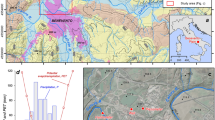Abstract
The construction of a grout curtain in karst is a very common procedure to reduce water loss from a reservoir. Long-term and short-term monitoring of water levels was performed on the Prevoj dam (Lazići water reservoir), located in the Dinarides of western Serbia, to determine the hydraulic behavior and functionality of the grout curtain in karstic media. Different approaches of time-series analysis were applied. Based on the long-term monitoring, and by application of correlation analysis and Rescaled Partial Sums—RAPS, water table fluctuations were analyzed to obtain a general trend and relation between piezometers at the immediate zone of grout curtain. Short term, but very frequent monitoring of water table in the reservoir (SWT) and piezometers, provided considerably better insight into hydraulic behavior in karstic media. The various methods of obtaining results showed that they are all comparative or complementary. The higher order partial correlation proved to be significant in the definition of dependence between observed piezometers, by removal of possible influences of other adjacent variables piezometers. Univariate time series were analyzed by the first difference serial dependencies, which considerably changed the identification of the seasonal effect on the water table at the water reservoir. This was used as a tracer to analyze the influence of the surface water reservoir on the behavior of water table of analyzed piezometers in rock mass. An analysis of the shape of hysteresis provided valuable information related to hydraulic behavior in karst media and conditions of the functioning of the grout curtain as a barrier. Separating the rising limb from the recession limb on hydrographs and presenting adjacent piezometers on correlograms (upward and downward from the grout curtain), provided an analysis of hysteresis loops. Based on this analysis, there can be better insight of flow circulation in karst, functioning of the hydraulic barrier and better focus on certain zones and controlling of water loss from the reservoir.











Similar content being viewed by others
References
Acworth I, Rau G, Halloran L, Timms W (2017) Vertical groundwater storage properties and changes in confinement determined using hydraulic head response to atmospheric tides. Water Resour Res 53:2983–2997
Bonacci O (2007) Analysis of long-term (1878–2004) mean annual discharges of the karst spring Fontaine de Vaucluse (France). Acta Carsologica 36(1):151–156
Box G, Jenkins G (1970) Time series analysis: forecasting and control. Holden-Day, San Francisco
Fiorillo F, Petitta M, Preziosi E, Rusi S, Esposito L, Tallini M (2015) Long-term trend and fluctuations of karst spring discharge in a Mediterranean area (central-southern Italy). Environ Earth Sci 74–1:153–172
Ford D, Williams P (2007) Karst hydrogeology and geomorphology. Wiley, England
Garbrecht J, Fernandez GP (1994) Visualization of trends and fluctuations in climatic records. Water Resour Bull 30:297–306
Goodman R (1980) Introduction to rock mechanics, 1st edn. Wiley, New York, pp 32–34
Houlsby A (1976) Routine interpretation of the Lugeon water-test. Q J Eng Geol 9:303–313
Jukić D, Denić-Jukić V (2015) Investigating relationships between rainfall and karst-spring discharge by higher-order partial correlation functions. J Hydrol 530:24–36
Larocque M, Mangin A, Razack M, Banton O (1998) Contribution of correlation and spectral analyses to the regional study of a large karst aquifer (Charente, France). J Hydrol 205:217–231
Mangin A (1994) Karst hydrogeology. In: Gilbert J, Danielopol DL, Stanford JA (eds) Groundwater ecology. Academic Press, Orlando, Florida, USA, pp 43–67
Milanović PT (1981) Karst hydrogeology. Water Resources Publication, Colorado
Milanović PT (2000) Geological engineering in karst. Monograph. Zebra Publishing Ltd, Belgrade, pp 83–88
Milanović S, LJ Vasić (2016) 3D conduit modelling of leakage below a dam situated in highly karstified rocks. In: Stevanović Z, Krešić N, Kukurić N (eds) Karst without boundaries. CRC Press, Balkema, pp 321–336 (ISBN 9781138029682)
Prokhorov AV (2001) Partial correlation coefficient. In: Hazewinkel Michiel (ed) Encyclopedia of mathematics. Springer, New York
Roje-Bonacci T, Bonacci O (2013) The possible negative consequences of underground dam and reservoir construction and operation in costal karst areas: an example of the hydro-electric power plant (HEPP) Ombla near Dubrovnik (Croatia). Nat Hazards Earth Syst Sci 13:2041–2052
Siegel S, Castellan NJ (1988) Nonparametric statistics for the behavioral sciences, 2nd edn. McGraw-Hill, New York
Author information
Authors and Affiliations
Corresponding author
Additional information
Publisher's Note
Springer Nature remains neutral with regard to jurisdictional claims in published maps and institutional affiliations.
This article is a part of a Topical Collection in Environmental Earth Sciences on Sustainable Management of Karst Natural Resources, guest edited by Drs. Sasa Malinovic and Zoran Stevanovic.
Rights and permissions
About this article
Cite this article
Jemcov, I. Impact assessment of grout curtain on the hydraulic behavior in karst, based on time a series analysis. Environ Earth Sci 78, 415 (2019). https://doi.org/10.1007/s12665-019-8412-z
Received:
Accepted:
Published:
DOI: https://doi.org/10.1007/s12665-019-8412-z




